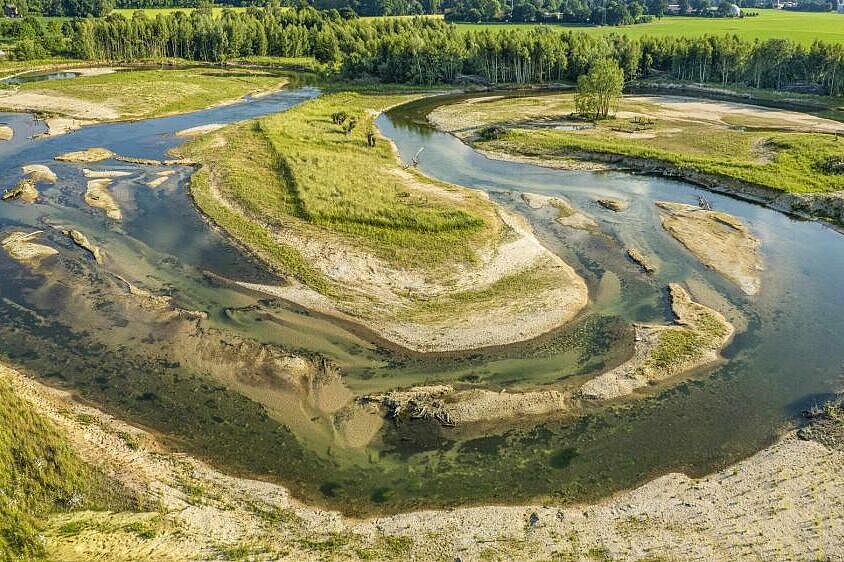New IGB Policy Brief

Revitalisation of Sande at the River Lippe in North Rhine-Westphalia. The measure was approved by the Detmold district government together with the planning office NZO GmbH from 2020-2021. | © Dr. Günter Bockwinkel NZO GmbH
Germany's rivers and their floodplains are important resources for us humans and valuable habitats for animals and plants. However, their ecosystem services are being jeopardised by advancing man-made climate change and the constantly increasing pressure of water use. River revitalisation is therefore an important strategic, long-term investment in the future that should not be put on the back burner by politicians and authorities, even in times of economic and security policy challenges. Researchers from the Leibniz Institute of Freshwater Ecology and Inland Fisheries (IGB) emphasise this on the occasion of the 2025 federal elections. In a new IGB Policy Brief, they recommend that federal policymakers prioritise and support the revitalisation of rivers much more strongly in close cooperation with the federal states.
"Rivers and floodplains provide us with drinking water resources, natural water retention and thus flood protection, pollutant retention and conversion, recreational and leisure areas and fishing resources. In order to make rivers in Germany more resilient, however, greater efforts are needed to revitalise them. The closer to nature a river is, the greater its biodiversity and the more extensive its ecosystem services," explains IGB researcher Prof Sonja Jähnig, head of department at IGB and co-author of the IGB Policy Brief. "A revitalised river is more resilient to negative impacts - and makes a greater contribution to mitigating the effects of climate change."
Major implementation deficit, strong conflicts of interest and urgent need for action
At present, only eight per cent of watercourses in Germany achieve the very good or good ecological status or the corresponding potential required by the European Water Framework Directive (WFD). However, all water bodies subject to reporting requirements should have reached this target by 2027 - the year after next. "This is utopian and shows that there has already been a major practical implementation deficit in improvement measures for two decades," emphasises Dr Jörn Gessner, IGB research group leader and co-author.
In 60 per cent of the water bodies, the implementation of the hydromorphological measures provided for in the management plans had not even begun by 2020. "The reasons for this are long and well known: Above all, there is a lack of money, personnel and land. There are also conflicts of interest with other policy areas such as agriculture, transport and energy. This is why water legislation alone is not enough to solve these problems," explains Jörn Gessner. After many years of detailed diagnosis, the researchers recommend that the focus should now be on solving specific practical problems and conflicting objectives.
Adequate resources, more efficient processes and pragmatism
The basic prerequisite for faster and more efficient watercourse revitalisation is official prioritisation with clear targets and sufficient resources. In addition, the complex and lengthy approval and implementation processes should be made more efficient and standardised as far as possible, without losing sight of the special features of the river catchment areas.
In addition to adapting the procedural regulations, this also requires a cultural change towards more progressive, pragmatic administrative action and greater exchange with knowledge bearers and stakeholders, such as conservation and user associations, in order to better integrate specialist and practical knowledge. A constructive culture of failure instead of the sole primacy of absolute legal certainty would create valuable revitalisation knowledge and help improve future implementations. Conflicts of goals and interests could be defused or even resolved if revitalisation projects were to focus more on multifunctional approaches with synergy effects that cover several objectives and interests simultaneously.
"In contrast, political support and prioritisation of ecologically very harmful river uses, such as small hydropower plants, which make no significant contribution to the energy transition and energy security, is counterproductive. Such misguided incentives should be urgently reassessed by legislators in the new legislative period," explains Dr Christian Wolter, IGB research group leader and also co-author. "The same applies to construction measures on rivers classified as waterways, which should be scrutinised much more critically for their necessity and their harmful ecological effects should be presented much more transparently in the cost-benefit balance sheet."
Continuing political initiatives and tapping economic potential
The Natural Climate Protection Action Programme (ANK) prepared by the Federal Ministry for the Environment and adopted by the current government, which also includes measures to revitalise water bodies, is a step in the right direction from the researchers' point of view and should be continued in a consistent, ambitious and well-funded manner.
The EU Nature Restoration Law (NRL) adopted in 2024, which provides among others for 25,000 km of newly free-flowing rivers in Europe, should be seen much more as an opportunity than a hurdle in the political arena. As the largest economy in the EU, Germany should seize this opportunity and make an ambitious contribution to these goals.
This commitment should not just be seen as a cost factor, but rather as a targeted investment: "Water and water bodies are strategic resources and river revitalisation is an important part of future-oriented, sustainable water and water body management. The increased revitalisation of rivers and floodplains can also provide economic impetus and establish a new sustainable market - similar to what has happened in the renewable energy sector," explains Christian Wolter. This innovative expertise also harbours international export and value creation potential.






